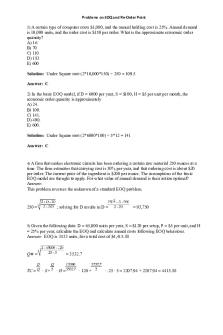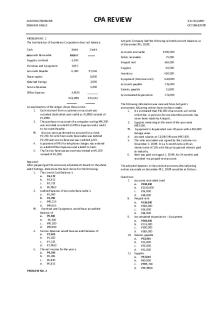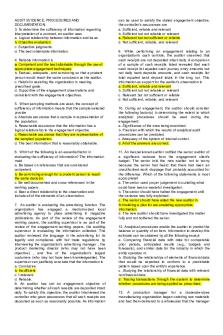Auditing Problems with Answers PDF

| Title | Auditing Problems with Answers |
|---|---|
| Course | Applied Auditing |
| Institution | Far Eastern University |
| Pages | 12 |
| File Size | 562.9 KB |
| File Type | |
| Total Downloads | 27 |
| Total Views | 135 |
Summary
AUDITING PROBLEMSPROBLEM NO. 1You are engaged in the regular annual examination of the accounts and records of PRTC Manufacturing Co. for the year ended December 31, 2012. To reduce the workload at year end, the company, upon your recommendation, took its annual physical inventory on November 30, 20...
Description
AUDITING PROBLEMS PROBLEM NO. 1 You are engaged in the regular annual examination of the accounts and records of PRTC Manufacturing Co. for the year ended December 31, 2012. To reduce the workload at year end, the company, upon your recommendation, took its annual physical inventory on November 30, 2012. You observed the taking of the inventory and made tests of the inventory count and the inventory records. The company’s inventory account, which includes raw materials and work-in-process is on perpetual basis. Inventories are valued at cost, first-in, first-out method. There is no finished goods inventory. The company’s physical inventory revealed that the book inventory of P1,695,960 was understated by P84,000. To avoid delay in completing its monthly financial statements, the company decided not to adjust the book inventory until year-end except for obsolete inventory items. Your examination disclosed the following information regarding the November 30 inventory: a. Pricing tests showed that the physical inventory was overstated by P61,600. b.
An understatement of the physical inventory by P4,200 due to errors in footings and extensions.
c.
Direct labor included in the inventory amounted to P280,000. Overhead was included at the rate of 200% of direct labor. You have ascertained that the amount of direct labor was correct and that the overhead rate was proper.
d.
The physical inventory included obsolete materials with a total cost of P7,000. During December, the obsolete materials were written off by a charge to cost of sales.
Your audit also disclosed the following information about the December 31 inventory: a.
Total debits to the following accounts during December were: Cost of sales P1,920,800 Direct labor 338,800 Purchases 691,600
b.
The cost of sales of P1,920,800 included direct labor of P386,400.
QUESTIONS: Based on the above and the result of your audit, determine the following: 1.
Adjusted amount of physical inventory at November 30, 2012 c. P1,845,760 b. P1,631,560 d. P1,722,560
2.
Adjusted amount of inventory at December 31, 2012 c. P1,502,760 b. P1,516,760 d. P1,425,760
3.
Cost of materials on hand, and materials included in work in process as of December 31, 2012 a. P819,560 c. P728,560 d. P942,760
4.
The amount of direct labor included in work in process as of December 31, 2012 a. P618,800 c. P338,800 d. P386,400
5.
The amount of factory overhead included in work in process as of December 31, 2012 a. P 772,800 b. P1,237,600 d. P777,600
PROBLEM NO. 2 PRTC Company's property, plant, and equipment, accumulated depreciation, and amortization balances at December 31, 2011 are:
Land Buildings Machinery and equipment Automobile and trucks Leasehold improvements Totals
Cost P 275,000 2,800,000 1,380,000 210,000 432,000 P5,097,000
Accumulated depreciation P 672,900 367,500 114,326 108,000 P1,262,726
Additional information on depreciation, amortization methods, and useful lives follows:
Asset Buildings Machinery and equipment Automobile and trucks (all acquired after 2009) Leasehold improvements
Depreciation method 150%-decliningbalance straight-line 150%-decliningbalance straight-line
Useful life 25 years. 10 years 5 years
Depreciation is computed to the nearest month. Salvage values of depreciable assets are immaterial except for automobiles and trucks which have estimated salvage values equal to 15% of cost. Other additional information: PRTC entered into a twelve-year operating lease starting January 1, 2009. The leasehold improvements were completed on December 31, 2008 and the facility was occupied on January 1, 2009.
On January 6, 2012, PRTC completed its self-construction of a building on its own land. Direct costs of construction were P1,095,000. Construction of the building required 15,000 direct labor hours. PRTC's construction department has an overhead allocation system for outside jobs based on an activity denominator of 100,000 direct labor hours, budgeted fixed costs of P2,500,000, and budgeted variable costs of P27 per direct labor hour.
On July 1, 2012, machinery and equipment were purchased at a total invoice cost of P325,000. Additional costs of P23,000 to rectify damage on delivery and P18,000 for concrete embedding of machinery were incurred. A wall had to be demolished to enable a large machine to be moved into the plant. The wall demolition cost P7,000, and rebuilding of the wall cost P19,000.
On August 30, 2012, PRTC purchased a new automobile costing P25,000.
On September 30, 2012, a truck with a cost of P48,000 and a carrying amount of P30,000 on December 31, 2011 was sold for P23,500.
On November 4, 2012, PRTC purchased a tract of land for investment purposes for P700,000. PRTC thinks it might use the land as a potential future building site.
On December 20, 2012, a machine with a cost of P17,000, a carrying amount of P2,975 on date of disposition, and a market value of P4,000 was sold to a corporate officer.
QUESTIONS: Based on the above and the result of your audit, compute for the following as of and for the year ended December 31, 2012: 6.
7.
Total depreciation a. P460,228 b. P462,678 Carrying amount of buildings a. P3,409,474
c. P470,528
c. P3,028,774 d. P3,381,274
8.
Carrying amount of machinery and equipment a. P1,197,375 c. P1,243,925 b. P1,180,275
9.
Carrying amount of automobiles and trucks b. P59,472
c. P61,722 d. P52,722
10. Carrying amount of property, plant and equipment a. P5,637,371 b. P5,608,771 d. P5,590,821 PROBLEM NO. 3 You noted the following items relative to the company’s Intangible assets in connection with your audit of the PRTC Corporation’s financial statements for the year 2012. Franchise On January 1, 2012, PRTC signed an agreement to operate as franchisee of Clear Copy Service, Inc. for an initial franchise of P680,000. Of this amount, P200,000 was paid when the agreement was signed and the balance was payable in four annual payments of P120,000 each, beginning January 1, 2013. The agreement provides that the down payment is not refundable and no future services are required of the franchisor. The implicit rate for loan of this type is 14%. The agreement also provides the 5% of the revenue from the franchise must be paid to the franchisor annually. PRTC’s revenue from the franchise for 2012 was P8,000,000. PRTC estimates the useful life of the franchise to be ten years. Patent On July 1, 2012, PRTC purchased a patent from the inventor, who asked P1,100,000 for it. PRTC paid for the patent as follows: cash, P400,000; issuance of 10,000 shares of its own ordinary shares, par P10 (market value, P20 per share); and a note payable due at the end of three years, face amount, P500,000, noninterest-bearing. The current interest rate for this type of financing is 12 percent. PRTC estimates the useful life of the patent to be ten years. Trademark PRTC purchased for P1,200,000 a trademark for a very successful soft drink it markets under the name POWER!. The trademark was determined to have an indefinite life. A competitor recently introduced a product that is in direct competition with the POWER! product, thus suggesting the need for an impairment test. Data gathered by the entity suggests that the useful life of the trademark is still indefinite, but the cash flows expected to be generated by the trademark have been reduced either to P40,000 per year (with a probability of 70%) or to P80,000 per year (with 30% probability). The appropriate risk-free interest rate is 5%. The appropriate riskadjusted interest rate is 10%.
QUESTIONS: Based on the above and the result of your audit, determine the following: (Round off present value factors to 4 decimal places) 11. Total expenses related to franchise in 2012 c. P448,950 d. P454,964
b. P535,200
12. Carrying amount of franchise as of December 31, 2012 a. P549,644 c. P538,733 d. P612,000 13. Carrying amount of patent as of December 31, 2012 a. P1,045,000 c. P860,310 b. P 955,900 14. Total expenses related to the intangible assets in 2012 a. P662,759 b. P711,709 d. P802,212 15. In auditing intangible assets, an auditor most likely would review or recompute amortization and determine whether the amortization period is reasonable in support of management’s financial statement assertion of . c. Completeness. b. Existence or occurrence. d. Rights. PROBLEM NO. 4 You are conducting an audit of the PRTC Company for the year ended December 31, 2012. The internal control procedures surrounding cash transactions were not adequate. The bookkeeper-cashier handles cash receipts, maintains accounting records, and prepares the monthly bank reconciliations. The bookkeeper-cashier prepared the following reconciliation at the end of the year:
Balance per bank statement Add: Deposit in transit Note collected by bank Total Less outstanding checks Balance per general ledger
P350,000 P175,250 15,000
190,250 540,250 246,750 P293,500
In the process of your audit, you gathered the following:
At December 31, 2012, the bank statement and general ledger showed balances of P350,000 and P293,500, respectively.
The cut-off bank statement showed a bank charge on January 2, 2013 for P30,000 representing correction of an erroneous bank credit.
Included in the list of outstanding checks were the following: a. A check payable to a supplier, dated December 29, 2012, in the amount of P14,750, released on January 5, 2013. b. A check representing advance payment to a supplier in the amount of P37,210, the date of which is January 4, 2013, and released in December, 2012.
On December 31, 2012, the company received and recorded customer’s postdated check amounting to P50,000.
QUESTIONS: Based on the above and the result of your audit, answer the following: 16. The adjusted deposit in transit as at December 31, 2012 is a. P175,250 c. P225,250 d. P125,000 17. The adjusted outstanding checks as at December 31, 2012 is a. P298,710 c. P209,540 b. P232,000 18. The adjusted cash to be presented in the statement of financial position at December 31, 2012 is a. P235,460 c. P265,460 d. P310,460 19. The cash shortage as of December 31, 2012 is a. P45,000 b. P58,040 d. P 8,040 20. The net adjustment to the cash account as of December 31, 2012 is c. P58,040 b. P60,000 d. P45,000 PROBLEM NO. 5 On January 1, 2012, PRTC Company sold land that originally cost P400,000 to Buyer Company. As payment, Buyer gave PRTC Company a P600,000 note. The note bears an interest rate of 4% and is to be repaid in three annual installments of P200,000 (plus interest on the outstanding balance). The first payment is due on December 31, 2012. The market price of the land is not reliably determinable. The prevailing rate of interest for notes of this type is 14% on January 1, 2012 and 15% on December 31, 2012. PRTC made the following journal entries in relation to the sale of land and the related note receivable: January 1, 2012 Notes receivable Land Gain on sale of land
P600,000 P400,000 200,000
December 31, 2012 Cash Notes receivable Interest income
P224,000 P200,000 24,000
PRTC reported the notes receivable in its statement of financial position at December 31, 2012 as part of trade and other receivables. QUESTIONS: Based on the above and the result of your audit, answer the following: 21. The correct gain on sale of land is b. P 94,868
c. P120,061 d. P200,000
22. Profit for 2012 is overstated by b. P31,130
c. P54,902 d. P 0
23. The entity’s working capital at December 31, 2012 is overstated by a. P235,765 c. P182,476 d. P 0 24. All of the following are examples of substantive tests to verify valuation of net accounts receivable except the a. Re-computation of the allowance for bad debts. . c. Inspection of the aging schedule and credit records of past due accounts. d. Comparison of the allowance for bad debts with past records. 25. Confirmation, which is a specific type of inquiry, is the process of obtaining a representation of information or of an existing condition directly from a third party. Two assertions for which confirmation of accounts receivable balances provides primary evidence are a. Completeness and valuation c. Valuation and rights and obligations d. Existence and completeness PROBLEM NO. 6 You were engaged by PRTC Corporation, a small and medium-sized entity, to audit its financial statements for the year 2012. During the course of your audit, you noted the following regarding its recent acquisitions of investments in equity securities: a) On 1 January 2012 the entity acquired 25 per cent of the equity of each of entities B, C and D for P10 million, P15 million and P28 million respectively. Transaction costs of 1 per cent of the purchase price of the shares were incurred by the entity. b) On 2 January 2012 entity B declared and paid dividends of P1 million for the year ended 2011. c)
On 31 December 2012 entity C declared a dividend of P8 million for the year ended 2012. The dividend declared by entity C was paid in 2013.
d) For the year ended 31 December 2012, entities B and C recognized profit of respectively P5 million and P18 million. However, entity D recognized a loss of P20 million for that year. e) Published price quotations do not exist for the shares of entities B, C and D. Using appropriate valuation techniques the entity determined the fair value of its investments in entities B, C and D at 31 December 2012 as P13 million, P29 million and P15 million respectively. Costs to sell are estimated at 5 per cent of the fair value of the investments. f)
The entity has no subsidiaries and therefore does not produce consolidated financial statements.
In accordance with section 14.4 of the PFRS for SMEs, an investor shall account for all of its investments in associates using one of the following: (a) the cost model in paragraph 14.5, (b) the equity method in paragraph 14.8, or (c) the fair value model in paragraph 14.9. The entity is seeking your advice on the effect of each method on the carrying amount of the investment and its effect on profit or loss. QUESTIONS: Based on the above and the result of your audit, answer the following as of and for the year ended December 31, 2012: 26. If the entity measures its investments in associates using the cost model, the total carrying amount of the investments should be a. P40.25 million c. P39.25 million b. P53.28 million 27. If the entity measures its investments in associates using the cost model, the net amount to be recognized in profit or loss should be c. P(11.03) million b. P(12.03) million d. P 2.25 million...
Similar Free PDFs

Auditing Problems with Answers
- 12 Pages

Density Problems with Answers
- 2 Pages

Auditing Test Bank with answers
- 30 Pages

Auditing Problems
- 28 Pages

Auditing Problems
- 22 Pages

Problems on EOQ with answers
- 5 Pages

AUDITING PROBLEMS (CPA REVIEW)
- 7 Pages

Quizzer in Auditing Problems
- 5 Pages

316323131-Auditing-Problems
- 8 Pages

Auditing Problems Summary
- 15 Pages

Auditing Problems Lecture Notes
- 24 Pages

Auditing Problems TB 1
- 31 Pages
Popular Institutions
- Tinajero National High School - Annex
- Politeknik Caltex Riau
- Yokohama City University
- SGT University
- University of Al-Qadisiyah
- Divine Word College of Vigan
- Techniek College Rotterdam
- Universidade de Santiago
- Universiti Teknologi MARA Cawangan Johor Kampus Pasir Gudang
- Poltekkes Kemenkes Yogyakarta
- Baguio City National High School
- Colegio san marcos
- preparatoria uno
- Centro de Bachillerato Tecnológico Industrial y de Servicios No. 107
- Dalian Maritime University
- Quang Trung Secondary School
- Colegio Tecnológico en Informática
- Corporación Regional de Educación Superior
- Grupo CEDVA
- Dar Al Uloom University
- Centro de Estudios Preuniversitarios de la Universidad Nacional de Ingeniería
- 上智大学
- Aakash International School, Nuna Majara
- San Felipe Neri Catholic School
- Kang Chiao International School - New Taipei City
- Misamis Occidental National High School
- Institución Educativa Escuela Normal Juan Ladrilleros
- Kolehiyo ng Pantukan
- Batanes State College
- Instituto Continental
- Sekolah Menengah Kejuruan Kesehatan Kaltara (Tarakan)
- Colegio de La Inmaculada Concepcion - Cebu



